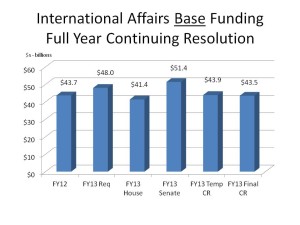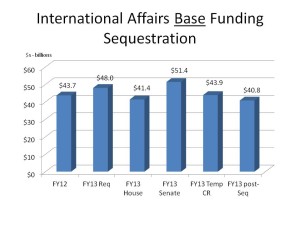
Developments on the budget front continue to evolve rapidly, so we are pleased to provide this latest installment of our “Budget Watch” that summarizes the status of the current budget negotiations and the impact on the International Affairs Budget.
As previously reported, Congress and the White House reached a “fiscal cliff” agreement at the beginning of this month on a limited revenue and spending reduction package that, while resolving the expiration of the Bush tax cuts, delayed the more critical decisions needed to avert sequestration and achieve a significant, long-term deficit reduction deal. Under this agreement, sequestration is now delayed until March 1 when the automatic spending cuts will occur if no further agreement is reached. This deadline will also approximately coincide with Treasury Department estimates of when the U.S. will hit the debt ceiling and slightly precede the March 27 expiration of the Continuing Resolution (CR).
In a late-breaking development, House Republicans announced Friday a plan to extend the debt ceiling limit until May 18. The proposal links the delay with an effort to force the Senate to act on a budget resolution for FY14, something the Senate has not done for the past three years. Under the terms of the Republican proposal (H.R. 325), which is expected to taken up by the House tomorrow, if the House or Senate has not adopted a budget resolution by April 15, Member salaries will be placed in escrow. The legislation, however, does not affect either the March 1 deadline for sequestration or the March 27 expiration of the CR.
With all this uncertainty surrounding the budget, what are the implications for International Affairs programs? In short, the spending cuts in the January 1 “mini-deal” are relatively small and will have a minor impact on appropriations for FY13 and FY14. However, the absence of a final deficit reduction package, the continuing threat of sequestration, no agreement on what to do when the CR expires, or potentially extending the debt ceiling limit until May 18 results in extraordinary uncertainty of the impact on International Affairs resources.
While we acknowledge that a complicated situation is only getting more complicated, we attempt below to present four scenarios of how things might unfold over the next two months and their respective impact on the International Affairs Budget. The first three scenarios are relatively defined, although only approximations of what may happen, with the possibility of a “wildcard” fourth scenario: a new deal emerges that doesn’t resemble anything we could possibly envision at present.
Scenario #1: Current FY13 Continuing Resolution is Extended
Under this scenario, the FY13 appropriations for International Affairs would total $54.7 billion — $43.5 billion in the “base” and another $11.2 billion for the Overseas Contingency Operations (OCO) account, a category that is not subject to the spending caps. This amount for International Affairs would be slightly less than the temporary CR and FY12 levels (1% and 0.4%, respectively).
The International Affairs Budget would be considered part of the “security” category, along with defense, homeland security, and veterans. As such, it is subject to relatively minor reductions due to a $2 billion cut in the FY13 security cap imposed by the recent ”fiscal cliff” deal, plus the fact that security programs under the temporary CR exceeded the old security cap by $4.8 billion. If the cuts are applied proportionately to all security programs, International Affairs would decline by about 1% compared with the current CR.
The wild card for this scenario is that an extension of a full-year CR is expected to include a number of alterations (referred to as “anomalies”) to the current formula and will, therefore, change somewhat from these projections.
Scenario #2:Congress enacts FY13 Omnibus
As previously reported, late last year House and Senate appropriators agreed to a conference package covering most spending bills. Although the details have not been released, International Affairs programs fared relatively well, suggesting final FY13 levels closer to the Senate than the House. If Congress enacted an omnibus appropriation, the overall package would be cut by $4 billion – divided evenly between security and non-security programs – due to reductions made to the FY13 discretionary spending cap in the recent “mini deal.” Once again under this scenario, the International Affairs Budget would be considered part of the “security” cap. Assuming that the omnibus generally tracked what Appropriators agreed to in December, this scenario would result in a 0.3% reduction for International Affairs from FY13 levels used by appropriators last year. Another unknown under this scenario is how appropriators might use the OCO account to reconcile the $10 billion difference between their base levels for International Affairs.
Scenario #3: Sequestration
In scenario #3, the International Affairs Budget would in reality be part of the non-defense category because the definition of “security” spending is amended and limited to Defense programs only. If sequestration becomes a reality, it appears to be the worst outcome for International Affairs, as well as for all discretionary spending. Without a comprehensive deficit reduction plan in place on March 1, OMB will enforce an across-the-board of roughly 7% (or perhaps less) for all non-defense appropriation accounts. Under the sequestration process, Defense spending absorbs half of the necessary cuts, with all other spending programs, including International Affairs taking the other half. The size of the non-defense sequestration – about 7% – is less than the 8.2% estimate issued prior to the New Years Day agreement because the total FY13 sequestration was also reduced by the “mini deal” which made an immediate $24 billion reduction, some of which was achieved through a revenue provision. A March 1 sequestration will need to reduce spending by $85 billion rather than the $109 billion previously.
Without a comprehensive deficit reduction plan in place on March 1, OMB will enforce an across-the-board of roughly 7% (or perhaps less) for all non-defense appropriation accounts. Under the sequestration process, Defense spending absorbs half of the necessary cuts, with all other spending programs, including International Affairs taking the other half. The size of the non-defense sequestration – about 7% – is less than the 8.2% estimate issued prior to the New Years Day agreement because the total FY13 sequestration was also reduced by the “mini deal” which made an immediate $24 billion reduction, some of which was achieved through a revenue provision. A March 1 sequestration will need to reduce spending by $85 billion rather than the $109 billion previously.
If sequestration is applied as illustrated above, International Affairs would fall nearly $3 billion (6.4%) below FY12 levels and $3.1 billion (7%) below the current CR. It would be by far the low water mark of any previously recommended amounts for base International Affairs levels in FY13 and a full $10.7 billion (20.7%) less than the $51.5 billion base FY10 International Affairs Budget.
Scenario #4: Grand Bargain Reached
A final scenario is that Congress and the President resolve their big differences over revenue increases, cuts to entitlements and discretionary spending, and how to raise the debt ceiling. Coupled with this could be the cancellation of sequestration, significantly revised spending caps over the next decade, and a new framework for FY13 appropriations. While this scenario is highly unlikely, there is no way to tell what this might mean for the International Affairs Budget. With a grand bargain, however, it is hard to imagine a scenario without additional discretionary spending cuts across all accounts.
Of course, Congress could certainly find a way to delay the big decisions with another mini-deal that includes another set of small spending cuts and new deadlines. We will be watching all of this closely.
The FY14 Budget: What’s Happening?
Given all the uncertainty over FY13, it’s not surprising that Administration efforts to finalize and submit to Congress its FY14 budget are in limbo. OMB has still not returned to agencies its changes to draft budgets (known as the “passback”), something that would normally have occurred in late November.
Without knowing the outcome for FY13 and how a comprehensive agreement might impact FY14, it is nearly impossible for the Administration to construct a budget blueprint for next year. The “mini deal” already lowered FY14 discretionary spending caps by $8 billion, divided between “security” and “non-security” in which, as mentioned above, International Affairs falls in “non-security.” Any package adopted between now and March 1 could very well include additional changes to the FY14 spending caps among other provisions.
It is clear that the original target date of February 4 will be missed – the President’s State of the Union, which always precedes the budget, will come on February 12. As there are few incentives for the Administration to finalize an FY14 plan if significant changes could come before March 1, an FY14 budget submission by mid-March – at the earliest – is more likely.
Exactly how the recent Republican proposal to suspend Member salaries if the House or Senate has not passed a budget resolution by April 15 will impact submission plans by the White House is also unclear.
How are Agencies Coping with the Uncertainty?
Even though Congress rarely enacts appropriations bills before the beginning of a new fiscal year on October 1, it is very unusual to go past January without knowing what the final spending levels will be — and perhaps unprecedented to be facing additional spending cuts with only six months left in the fiscal year. Budgeting effectively under such uncertain circumstances becomes a daunting task.
Program managers at all U.S. foreign affairs agencies are taking precautions to allow for adjustments when final decisions are reached. In some cases, where International Affairs accounts have multi-year spending authority – Embassy Security, National Endowment for Democracy, USAID Development Assistance, Global Health, and Economic Support Fund, to name a few – the challenges are less. Limited amounts of funds are being obligated at this point, but when lawmakers settle on final appropriations, program managers will have until September 30, 2014 or beyond to make allocations and obligate funds.
The greatest concern rests with International Affairs accounts in three other areas: operating expense accounts for the State Department and USAID, humanitarian assistance and those with single year authority to obligate (such as Foreign Military Financing and Non-Proliferation, Anti-Terrorism, and Demining). Humanitarian programs probably face the most uncertainty, not only from over their final funding levels but also the demands that will arise in the coming months, such as the ongoing crisis in Syria and the growing concern in Mali.
Sequestration: How will it Work?
If OMB orders sequestration, it will apply the cuts to each “Program, Project, and Activity,” (PPA) an arcane budgetary term with different definitions for each appropriations bill. While foreign affairs agency budget managers are still considering how the sequestration cuts will be applied, it appears there will likely be four buckets for International Affairs programs.
Regardless of how policymakers ultimately decide to manage the sequestration process, this will be the starting point for finalizing FY13 allocations among countries, programs, and purposes. The Administration has re-programming authority that they are likely to use to modify account funding levels that emerge from the sequestration process in order to better align resources to current priorities and demands and not those set for FY12 that is largely the baseline for applying the across-the-board reductions. However, the Administration will need to work closely with Appropriators in deciding final funding levels.